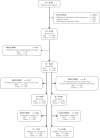Pre-Birth and Early-Life Factors Associated With the Timing of Adiposity Peak and Rebound: A Large Population-Based Longitudinal Study
- PMID: 35004537
- PMCID: PMC8727998
- DOI: 10.3389/fped.2021.742551
Pre-Birth and Early-Life Factors Associated With the Timing of Adiposity Peak and Rebound: A Large Population-Based Longitudinal Study
Abstract
Background: The late occurrence of adiposity peak (AP) and the early occurrence of adiposity rebound (AR) are considered the earliest indicators for obesity and its related health conditions later in life. However, there is still limited information for their upstream factors. Therefore, in this study, we aimed to identify the parental and child factors associated with the timing of AP and AR in the early stage of life. Methods: This is a population-based longitudinal study conducted in Shanghai, China. The BMI data of children born between September 2010 and October 2013 were followed from birth to 80 months. Subject-specific body mass index trajectories were fitted by non-linear mixed-effect models with natural cubic spline functions, and the individual's age at AP and AR was estimated. The generalized linear regression models were applied to identify the upstream factors of late occurrence of AP and early occurrence AR. Results: For 7,292 children with estimated AP, boys were less likely to have a late AP [adjusted risk ratio (RR) = 0.83, 95% confidence interval (CI): 0.77-0.90, p < 0.001], but preterm born children had a higher risk of a late AP (adjusted RR = 1.25, 95% CI: 1.07-1.47, p < 0.01). For 10,985 children with estimated AR, children with breastfeeding longer than 4 months were less likely to have an early AR (adjusted RR = 0.80, 95% CI: 0.73-0.87, p < 0.001), but children who were born to advanced-age mothers and who were born small for gestational age had a higher risk of having an early AR (adjusted RR = 1.21, 95% CI: 1.07-1.36, p < 0.01; adjusted RR = 1.20, 95% CI: 1.04-1.39, p = 0.01). Conclusions: Modifiable pre-birth or early-life factors associated with the timing of AP or AR were found. Our findings may help develop prevention and intervention strategies at the earliest stage of life to control later obesity and the health conditions and diseases linked to it.
Keywords: adiposity peak; adiposity rebound; body mass index; growth trajectory; obesity.
Copyright © 2021 Lin, Chen, Huang, Li, Wen, Wang and Shi.
Conflict of interest statement
The authors declare that the research was conducted in the absence of any commercial or financial relationships that could be construed as a potential conflict of interest.
Figures
References
LinkOut - more resources
Full Text Sources
Research Materials


